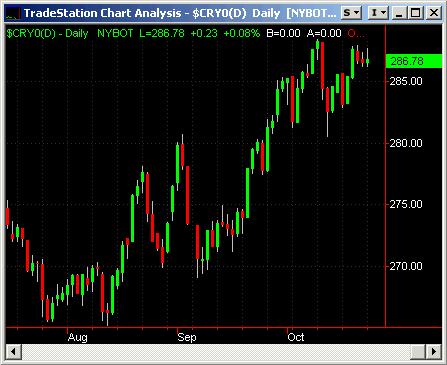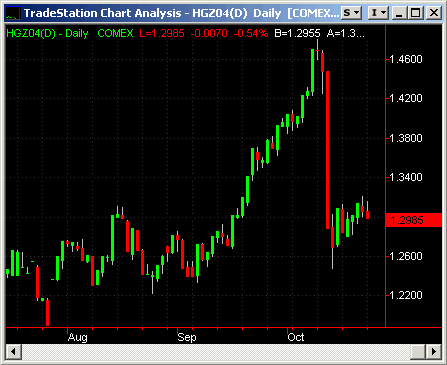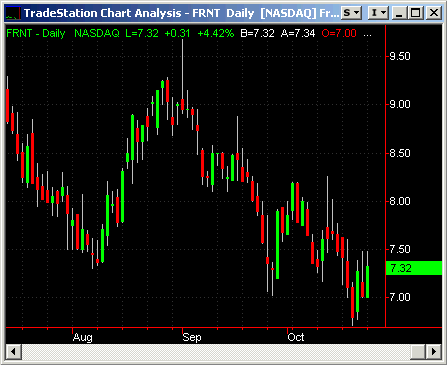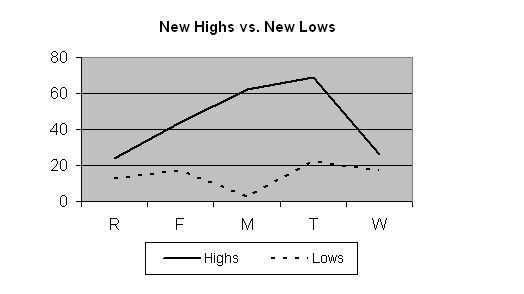Global Equity Rally: 3 Steps Forward And 2 Steps Back
Global Rally
Correction Underway
Â
A handful of reports indicating
weaker than expected growth in the US and abroad have sent resource markets
reeling. Note the chart on December Copper. Copper was leading the base metals
to new highs, helping resource producing countries lead the equity market
rally. But within a few short sessions, speculators unwound their positions
with such ferocity that the entire commodity thesis has fallen back pretty
sharply. Oil continuing to soar above $50 a barrel hasn’t helped concerns that
the global stabilization of growth is under threat.
Â
Bernanke and Greenspan are both
blinking. They are telling the markets that the pace of tightening will slow
dramatically and can blame oil prices for the deceleration they failed to
acknowledge earlier. The good news then is that one of the keys to a continued
global equity rally has fallen into place — the Fed is set to slow the pace of
tightening and the tightening cycle may be over for a while after another rate
hike or two. Now what is needed is for oil prices to stop exploding, for bonds
not to fall apart, and for the dollar to decline. The dollar is flirting with
the 87 level and Euro 1.25 level — if these give way it should indicate at least
a retest of the dollar’s lows and that would help cushion the oil shock blow and
help keep the economy, and eventually after correction, the mini-bull global
equity move, afloat.Â
Â

Â

Â
But technical and internal
damage has been done to the bull market and some possible further tough weeks
ahead loom, even if the above scenario plays out and the global bull move
reasserts itself. And new clear leadership must develop, which may be different
than the leadership of this leg up now past. It’s three steps forward and two
steps back for the global equity rally.
^next^
Our model portfolio followed in TradingMarkets.com with specific entry/exit/ops
levels from 1999 through May of 2003 was up 41% in 1999, 82% in 2000, 16.5% in
2001, 7.58% in 2002, and we stopped specific recommendations up around 5% in May
2003 (strict following of our US only methodologies should have had portfolios
up 17% for the year 2003) — all on worst drawdown of under 7%.  This did not
include our foreign stock recommendations that had spectacular performance in
2003.Â
This week in our Top RS/EPS New Highs list published on TradingMarkets.com, we
had readings of 24, 44, 62, 69, and 26 with 8 breakouts of 4+ week ranges, no
valid trades and one close call in CBUK. Breadth is expanding again and more
close calls would be a call to add some long exposure. Position in valid 4+
week trading range breakouts on stocks meeting our criteria or in close calls
that are in clearly leading industries, in a diversified fashion. This week,
our bottom RS/EPS New Lows recorded readings of 13, 17, 3, 22, and 17 with 12
breakdowns of 4+ week ranges, one valid trade in FRNT and no close calls. We’re
still not getting a lot of trading signals in valid breakouts, though the
environment is improving slightly on the long side — let’s see if this holds up
now that some resistance levels are close at hand.

For those not familiar with our long/short strategies, we suggest you review my
book
The Hedge Fund Edge, my course “The
Science of Trading,”
my video seminar, where I discuss many
new techniques, and my latest educational product, the
interactive training module. Basically,
we have rigorous criteria for potential long stocks that we call “up-fuel,” as
well as rigorous criteria for potential short stocks that we call “down-fuel.”
Each day we review the list of new highs on our “Top RS and EPS New High List”
published on TradingMarkets.com for breakouts of four-week or longer flags, or
of valid cup-and-handles of more than four weeks. Buy trades are taken only on
valid breakouts of stocks that also meet our up-fuel criteria. Shorts are
similarly taken only in stocks meeting our down-fuel criteria that have valid
breakdowns of four-plus-week flags or cup and handles on the downside. In the
U.S. market, continue to only buy or short stocks in leading or lagging
industries according to our group and sub-group new high and low lists. We
continue to buy new long signals and sell short new short signals until our
portfolio is 100% long and 100% short (less aggressive investors stop at 50%
long and 50% short). In early March of 2000, we took half-profits on nearly all
positions and lightened up considerably as a sea of change in the
new-economy/old-economy theme appeared to be upon us. We’ve been effectively
defensive ever since, and did not get to a fully allocated long exposure even
during the 2003 rally.

We continue to believe that a playable rally is underway, but that it entails
significant shock-risk. The rally is catchable for traders, who know how to mix
outright longs with relative value plays that feature the strongest sectors over
the market as a whole or weaker sectors. We suggest less than normal allocation
however. The good news is the trading range environment is ending.Â
Mark Boucher
